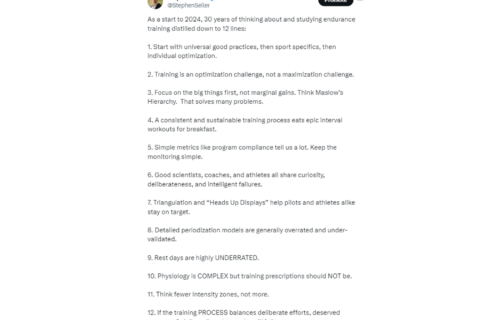Coach Connor busts several myths as he discusses the good, the bad, and the ugly of CTL.
Video Transcript
Trevor Connor 00:00
We’ve been getting a lot of questions lately about CTL is my CTL. high enough? What happens if I take a week off? Is it going to tank it is that going to affect my performance. So today, I’m going to bust a few myths and talk to you about the good, the bad, and the ugly of chronic training loading.
Chris Case 00:25
Welcome to fast Talk laboratories, your source for the science of endurance performance.
The good, the bad and the ugly of CTL
Trevor Connor 00:35
So let’s start with a standard CTL. Graph. This you can see in almost any training software, this is your blue line here, we’re looking at 500 days for this athletes. So this is their previous season, you can see their heights, you can see where they’re at now. There are good things of that. So I’m going to tell you quickly the good, the bad and the ugly of the CTL. Graph. The good is it is a useful metric, it is going to show somewhat your overall level, if you’re talking to a top tour Pro, their CTL is going to get up around 160. If you have a new athlete, they’re probably going to be in the 50 to 60 range. And depending on what level you want to be at, there’s approximate CTL that you want to be at, but it’s a pretty big range. So it is a useful metric. It can also show the athletes progress over the season. But there is bad to it. One of the bads is I see too many people set CTL as a goal, they think I’ve got to hit a certain CTL number, I hit that number, I can be performing my best last year I was 80 this year, if I can get to that 90, I’m going to be better. That’s not how it works. And I’m going to show you why in a minute. The other bad is to think that this shows how good you are. So same sort of thing. I’m better at 120 than I am at 110. Again, I’m going to show you why that’s not the way to think about it. The Ugly is when you get focused on these two things. And you get off track and you start training to raise your CTL that is where training can get really bad. One of the biggest issues is you take a Recovery Week, which we need remember, fundamental principle of training is do some stress to your body, and then let the body repair in recovery. If you are focusing on CTL, that recovery gets scary because the recovery, we can drop your CTL 20 points. And I’m seeing more and more athletes scared to take that recovery. Because CTL is going to come down. That’s the ugly. That’s where you get off track. That’s where you start pushing overtraining, I’m going to give you an example. So let’s start with I have two examples today. Let’s start with this one. This is just a 55 year old recreational athlete who I coach. He doesn’t actually race doesn’t have a race license. When he came to me one of his biggest goals is there’s this ride that goes from Toronto to this cottage country north of Toronto called Muskoka. It’s about a six and a half hour ride. He does it with all his buddies. And he was getting killed on this ride every summer, often getting popped. And he came to me and said, this is one of my big goals. I just want to hang with these guys. So this season, we really worked on building him to be able to do this right. So I’m going to point out two points on his CTL graph. So this is a CTL graph up here. Down here, you’re seeing his weekly training stress. Here you can see the peak in his CTL. This was back in March, we were doing a training camp, he had never hit a 90 CTL. He said I really want to hit it. So against my better judgment. We did it we got him up pretty high. But I can tell you, this is the highest point in his CTL.
Analyzing CTL for a long ride
Trevor Connor 03:37
That is not when he was performing as best over here is when he did this Muskoka ride that he was so excited about and really building towards all season. And actually, this big jump is because of the ride. So he went into that ride at about a 72-73 CTL. So a lot of people would consider that pretty low. Let’s take a look at how that ride went. Here’s the the heat map for this ride. So this shows power heat map, this shows heart rate. There isn’t a ton to see here. You know average power was 194 was about a 300 TSS so pretty big ride at six and a half hours. I would certainly notice that. But the reason I’m showing this is I have him do long base rides more normally closer to four hours all the time. If I hadn’t known this was his big target race, and he had posted this, and I took a look at it, I would have gone. Boy that was a long ride but good base ride, because that’s what it looks like to me. And let me emphasize this. I’m going to show you another graph. Here’s his heart rate graph overtop of his training ranges. And I’m going to highlight one particular or two ranges here. On Seilors three zone model. This is zone one. Look at his heart rate.
Trevor Connor 04:53
It is almost entirely in that zone one. This was a base ride for him. And let me tell you how he performed. It was a big group, guys that used to pop him. Other guys were getting popped by this second half of the ride where you can see his heart rate starting to go up a little bit. It was him. And a guy named Sean who I used to race as a pro, who were on the front, it was down to the two of them, going out one another, trying to beat everybody up with all these guys. He used to pop him sitting on their wheel just trying to hang on at the end of this ride. And the reason I’m using this as an example, a bunch of those guys went up to him and just went, Oh my God, you are stronger than we have ever seen you what’s going on with your training, a bunch of them asked him, what’s your CTL because CTL is becoming this more and more important metric for people. They’re like what your CTL is at 110 120. When he told him he’s down around 70, they would not believe him, they couldn’t believe he was performing that strong at a 70. So that’s an example of the focusing on the number thinking that the higher number means you’re better if you’re 110 and somebody is 100 you’re gonna beat them, not the way it works. He had the lowest CTL of anybody on that ride. Just wanted to point this out quickly. This was the day after his six and a half hour ride, he was actually a little disappointed in the ride because it just wasn’t that hard for him. So he went out and did this ride on his own, it was two and a half hours 246 average wattage compared to 194 on the previous day. Most of those guys had they gone on this ride with him, he just would have dropped them.
Masters Athlete CTL analysis
Trevor Connor 06:33
So let’s give you another example. This is a more competitive Master’s athlete, this is actually an athlete is right around 50, who’s got the potential to win nationals. So his CTL is going to be a little higher, he’s not down around that 70 he got up higher. But here’s a good example of the ugly because this athlete got focused on that CTL and really said, I need to be up in that 110-120 range focused on that more than he focused on proper training. And you really see it down here. So he wanted to be 110 he did the math CTL is basically averaging of your weekly TSS, so he knew to be at 110. His weekly TSS need to be right around 750. And except for these two weeks, that’s what he was sitting at each of these weeks is right around 750. So he had this really big week, I wanted him to take a Recovery Week and he didn’t do it. That looks like a smaller week. But it was about 400-450 TSS, that wasn’t a true Recovery Week. And he even admitted he came out of that week, not feeling fully recovered, then did a four week block of 750, where he just never got back on top of it. His body couldn’t adapt. It wasn’t getting that recovery. And he kind of flattened out. So we changed his approach. He basically over trained a little. And we had to back down for four weeks. And now we’re getting into a better training approach. Where you can see we’re doing these three week blocks that you know, these two are right around 900. These three here are up in the eight hundreds. So he’s doing these bigger weeks. But then following up with a Recovery Week, a true Recovery Week, like this one right here. He did less than two hours of training. That’s less than 100 TSS. And his credit, he finally was okay with that, because he knew that Recovery Week was going to tank his CTL. So he was bringing it back up. He was getting into hundreds he was excited, tanked on that Recovery Week, brought it back up tanked on that Recovery Week, but I was explaining to them, that’s better training, you’re beating up your body are actually doing bigger, harder weeks, and then you’re getting a full rest and your body’s gonna adapt better. But your CTL is going to look great. And to his credit, he was willing to say that didn’t work keeping up here. Let’s see what that does. And now let me show you the results. He has this weekly training race that he does. It’s here in Boulder, it goes Tuesdays and Thursday nights. So he would go once a week, here’s May 6th, when the CTL was 107. Here’s just a couple days ago, August 3rd CTL 82. That’s a big difference. Let’s take a look at the race. So the race is just over an hour. First, let’s compare the wattages. So you can see average wattage for the race a little higher on August 3rd, but pretty similar. But let’s take a look at this 20 minute power 295, 319 five minute power 364, 386 one minute power 423, 462. This was a stronger race. But you can just say well, maybe it’s just a harder group there. And he was just going harder. But now let’s take a look back at his heart rate. This one where he’s putting out lower wattage, heart rates sitting right at threshold. Now, when I have an athlete do a training race, I always tell them, training races are not the time to raise smart training races or the time to race hard because it’s in the name. This is training. I want beating yourself up. So I kept telling them in the spring when he’s going to these races, I want you to attack and for a few weeks, he kept in his report saying, I’ll try it next week, I didn’t, you know, I just want to get the feel for the race this week. Finally, after a few weeks of that he admitted to me, I can’t, I’m at my limit, I don’t have it in me to attack. Now let’s take a look at August 3rd, again, CTL, much lower. Look at his heart rate, for the first part of the race, touched threshold once, most race, he’s sitting comfortably. So up here where he’s just hanging on, send the first part of the race, sitting comfortably. Now look over here. And again, over here. So let me go to the the final slide here and show you what was going on at those two moments. So again, I’ve highlighted them. Here’s the race course, this first part here, this climb, is this stretch of the course. It’s into a headwind, it’s uphill, it’s a really hard part to attack on. That’s you, we periodically get pros to come out to this race. Right now we got two Olympic triathletes who are coming out, you get really strong athletes to come out to this. So it’s kind of a badge of pride to attack on this stretch. Because if you can get away and stay away there, man, you’re strong. And if you don’t, you get caught your popped, your race is done. So it’s a dangerous place to attack and big badge of pride for getting away. He attacked early right after they went around that corner and they caught him. So he attacked again. And he was away for about five minutes to the top. He actually did it, which kudos to him, especially as a 50 plus masters athlete. So that was impressive. They came down the hill, they recovered some more racing in here, they get to the final stretch of the course, which is this part right here. The spread finishes right in there. He just got on the front of the fields, he was listening to what I told him frankly, feeling amazing, going wow, I’m no longer just hanging on, I can actually do something this race, got on the front of the field, and just pulled for about 11 minutes doing about 330-340 watts, and then hit the climb where the big attack for the finish happens. Somebody came around him he was second wheel over the top of that climb after sitting on the front pulling for 11 minutes. Again, wanna emphasize this CTL of 82. In the spring, he was 107. And just hanging on in this race. That was a difference. So that’s the ugly of CTL, you get focused on it, you start thinking that the higher it is, the better I am and I got to get that CTL number up, and I’m going to perform better gets you off track, it can start pushing that overtraining like this athlete did now that he’s not focusing and CTL and he’s training better. The difference in his performance is extraordinary. And the only price was just bringing a number down a little bit.
Conclusion on CTL
Trevor Connor 12:58
So I hope I was able to show you that chronic training load is a useful metric. But it’s not everything. Don’t obsess it. Don’t get concerned if it comes down a little bit. At the end of the day. It’s how you perform out in the road.



